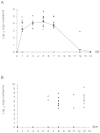Transmission of Ebola virus from pigs to non-human primates
- PMID: 23155478
- PMCID: PMC3498927
- DOI: 10.1038/srep00811
Transmission of Ebola virus from pigs to non-human primates
Abstract
Ebola viruses (EBOV) cause often fatal hemorrhagic fever in several species of simian primates including human. While fruit bats are considered natural reservoir, involvement of other species in EBOV transmission is unclear. In 2009, Reston-EBOV was the first EBOV detected in swine with indicated transmission to humans. In-contact transmission of Zaire-EBOV (ZEBOV) between pigs was demonstrated experimentally. Here we show ZEBOV transmission from pigs to cynomolgus macaques without direct contact. Interestingly, transmission between macaques in similar housing conditions was never observed. Piglets inoculated oro-nasally with ZEBOV were transferred to the room housing macaques in an open inaccessible cage system. All macaques became infected. Infectious virus was detected in oro-nasal swabs of piglets, and in blood, swabs, and tissues of macaques. This is the first report of experimental interspecies virus transmission, with the macaques also used as a human surrogate. Our finding may influence prevention and control measures during EBOV outbreaks.
Figures


References
-
- Leroy E. M. et al. Fruit bats as reservoirs of Ebola virus. Nature 438, 575–576 (2005). - PubMed
-
- Barette R. W. et al. Discovery of swine as a host for the Reston ebolavirus. Science 325, 204–206 (2009). - PubMed
-
- WHO,. Ebola Reston in pigs. and humans,. Philippines. Weekly Epidemiological Record 7, 47–50 (2009). - PubMed
-
- Marsh G. A. et al. Ebola Reston virus infection in pigs: clinical significance and transmission potential. J. Infect. Dis. 204 (Suppl.3), S804–S809 (2011). - PubMed
-
- Jahrling P. B. et al. Experimental infection of cynomolgus macaques with Ebola-Reston filoviruses from the 1989–1990 U.S. epizootic. Arch Virol Suppl 11, 115–134 (1996). - PubMed
Publication types
MeSH terms
Substances
LinkOut - more resources
Full Text Sources
Medical

